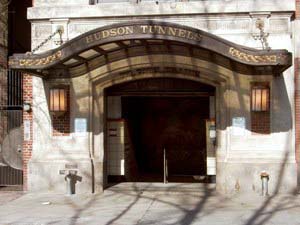A transportation tunnel under the Hudson River connecting Manhattan and New Jersey was first considered in the 1860s, fueled by New York City's rapidly growing congestion and the inadequacy of existing ferry service to population centers across the river. DeWitt Clinton Haskin, an engineer formerly with the Union Pacific Railroad, started the project in 1874 and subsequently endured an extended lawsuit, several failures of the tunnel wall, and an exhaustion of funds before quitting in 1887 with only 1,600 feet completed.
Two years later, a British team took up the project only to be halted in 1891 by a financial crisis, just 1,600 feet short of completion. William G. McAdoo, a Southern attorney who later served as Secretary of the Treasury under President Woodrow Wilson, finally completed the tunneling project. McAdoo later added another tunnel, extended the rail line into upper Manhattan, and helped connect its 33rd Street station, later known as Pennsylvania Station, with commercial real-estate development.
Facts
- The Hudson and Manhattan tunnel was the first large transportation tunnel constructed under a major river in the United States. A bridge connecting Manhattan and New Jersey was considered a more tenuous possibility because the Hudson River's bottom was known to consist solely of deep mud in some places.
- DeWitt Haskin's work plan involved sealing the tunnel and filling it with 35 pounds of air pressure to expel water and hold the tunnel's iron-plate liners in place. Workers entered through a concrete wall equipped with an air lock. Unfortunately, the compressed air could not keep the tunnel walls sealed, and blow-outs occurred in 1880 and 1882, flooding the work site.
- A British engineer, Sir Thomas Cochrane, used compressed air in devising the first pneumatic caisson -- or air-tight chamber -- in 1830. In the early 1870s, James Buchanan Eads used pneumatic caissons in constructing the foundations for his celebrated Eads Bridge crossing the Mississippi River at St. Louis, Missouri.
- The British team adapted technology used in the 1860s construction of London's subway by combining a shield to support the tunnel walls with Haskin's application of pneumatic pressure to the work face. The Greathead shield, named after its designer, has served as a prototype for all subsequent tunneling equipment.
- William McAdoo recommenced work in 1902, hiring Charles Jacobs as his chief engineer. Jacobs had built the first underwater tunnel in the city, an eight-foot-diameter bore for gas mains under the East River. Before completing the tunnel, the pair encountered solid rock that took 11 months of careful blasting to excavate.
- The Hudson and Manhattan Railroad Company formed the basis for the Port Authority Trans-Hudson (PATH) system in northeastern New Jersey and Manhattan that extended 14 miles, includes 13 stations, and serves more than 200,000 passengers a day.
Resources
-
Anthony Fitzherbert, William G. McAdoo and the Hudson Tubes ; Electric Railroaders Association, 1964
-
Brian J. Cudahy, Rails Under the Mighty Hudson ; Stephen Greene Press, 1975
-
Engineering News-Record , "125 Years in ENR History" (1999)
-
Paul Carleton, The Hudson & Manhattan Railroad Revisited ; D. Carleton Railbooks, 1990
-
S. D. V. Burr, Tunneling Under the Hudson River , John Wiley & Sons, 1885.



